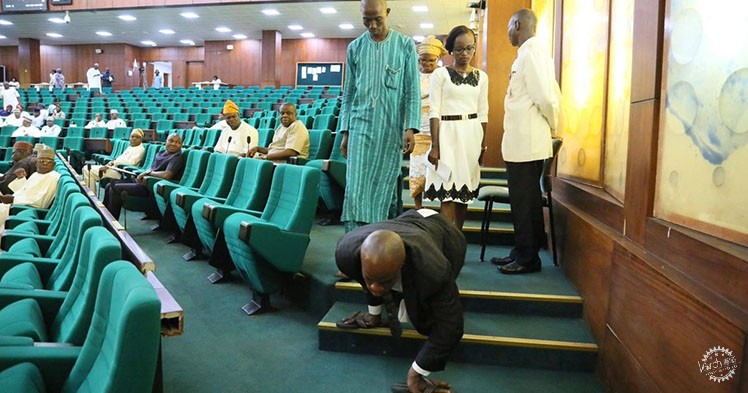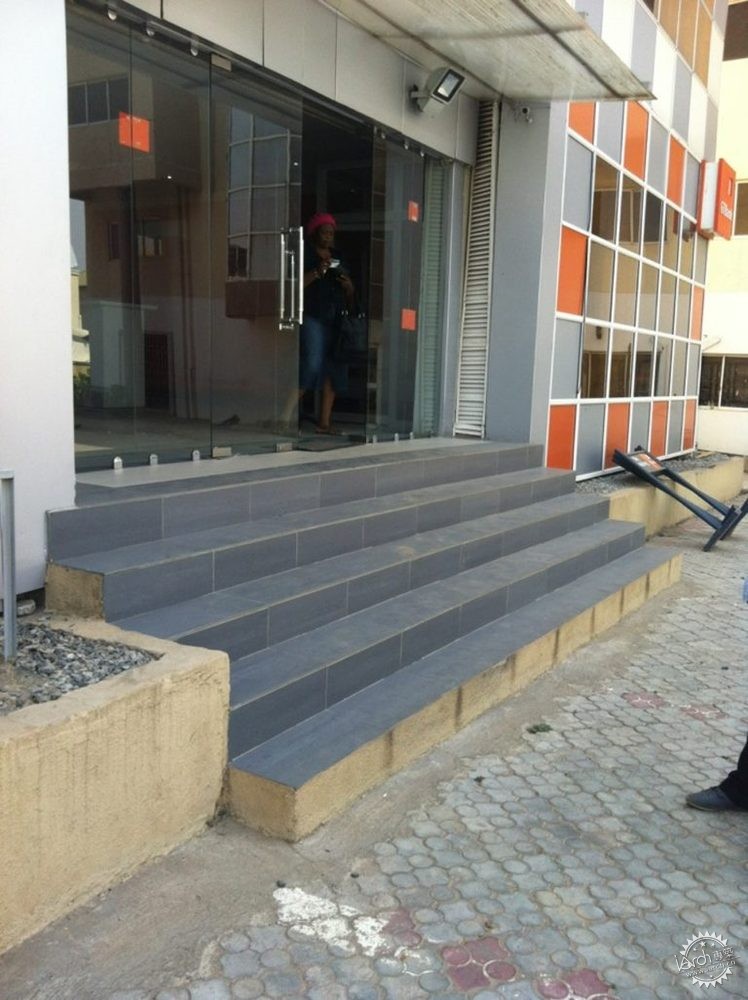
Image via Sahara Reporters on Twitter
非洲残障人士的不便之处(建筑师该如何解决这个问题?)
How African Cities Are Failing People with Disabilities (And What Architects Can Do About It)
由专筑网李韧,韩平编译
本文最初发表于Common Edge,标题为“非洲国家对残障人士的无硝烟战争”。
最近我花了一个多星期的时间与来自欧洲、美国、非洲的研究者们进行多学科小组学术研究工作,研究主题为“非洲城市的政治与实践”。来自马拉维科技大学的教授Jonathan Makuwira发表了一篇论文,标题为“马拉维的残障人士与城市主义”,这篇文章突出了当地非洲残障人士所面临的诸多挑战。
在本次研讨会中,各位专业人士重申了对残疾人所能使用的城市公共空间的严重不足的看法。这也是我2016年在哈佛大学研究生院申报理查德•罗杰斯奖学金的研究课题,当时我建议以奖学金的形式来重塑城市公共空间。
考虑到这一周所发生的各项时间,Makuwira的讲话似乎是一场及时雨。本次研讨会的负责人、瑞典马尔默大学的政治学博士、高级讲师Steve Marr先生也是一位需要轮椅代步的人士,这段时间我通过他的视角了解了更多有关城市的各项残障设施。正如我们所预期的那样,他无法独立去往大多数公共场所,因为轮椅通行不便,抑或是电梯故障等原因,这给他的工作生活带来了诸多不便。
在挪威大使馆的圆桌会议之后,我们出发步行前往瑞典大使馆。短短的路上随处可见各种障碍,Steve好几次都必须离开轮椅、并在别人的帮助下才能继续前行,这些场景看上去既无助又心碎。虽然Steve先生对于这种情况已经是司空见惯,但是我也感同身受,作为一个在尼日利亚首都阿布贾进行设计工作的设计师,我完全体会到解决残疾人问题的迫切程度。
如果这样描述还无法打动你,那以下画面你一定会随之动容,那时在阿布贾众议院,一位高位截瘫的人从会议大厅一侧的台阶上匍匐而下,而旁边的议员则冷漠地注视着他。
“后来网友在推特上发文说道:尼日利亚的国会议员每年都有几十亿的预算,就不能设计一个残疾人通道吗?@HouseNGR @nassnigeria@bukolasaraki @YakubDogara你们真应该来体验一下这种耻辱!
——Sahara Reporters (@SaharaReporters)2017年12月5日”
更加讽刺的是,这个事件发生的前几天正是世界残疾人日,在那一天,非洲大陆倡导团体还举办了各式各样的工作坊与研讨会。甚至一个小小的报纸专栏作家都愿意为残疾人的权利而发声。
纵观整个世界,各个城市都在制定各项设计标准来满足残疾人士的各项需求。然而在非洲的大多数城市里并没有完善的规范制度,许多地区并没有将残疾人士的需求转化为实际措施,非洲大多数公共建筑的设计布局常常表达着对残疾团体的忽视。例如阿布贾的城市街道根本不利于残疾人的通行,他们在这里举步为艰。而道路上那些直接裸露的障碍设施让普通人的通行已经足够艰难,更何况是不便的残疾人。
这里的大多数建筑师和设计师都不理解无障碍设施的重要性,因为这些内容在学校期间也很少教授,甚至在工作后也不多强调。对于大多数设计师来说,无障碍设施只是一些轮椅坡道而已。公共停车场也没有设置专用的残疾人通道。这里的建筑师很少考虑残疾人的不便之处,也没有考虑人体工程学,这样的设计结果就是,可能会保留相应的空间场所,但残疾人却仍然无法使用。而公共浴室的配置也考虑欠缺。这些并不是个例,当前,城市中大部分ATM机也无法供残疾人使用,这迫使他们只能从第三方进行交易,从而大大增加了盗窃和诈骗的犯罪率。
This article was originally published by Common Edge as "Africa’s Undeclared War on the Disabled."
Recently I spent part of a week in the company of a multidisciplinary group of academics and researchers from Europe, the US, and Africa, at a workshop entitled “The Practice and Politics of DIY Urbanism in Africa.” Jonathan Makuwira, a professor from the Malawi University of Technology, delivered a compelling paper on “Disability and Urbanism in Malawi,” highlighting the many challenges of the continent’s disabled population, using that city as a case study.
The lecture reaffirmed my sentiments on the gross inadequacies of urban public spaces for the disabled. It’s an issue that formed the basis for my 2016 entry for the Richard Rogers Fellowship at the Harvard Graduate School of Design (GSD), where I had proposed to use the fellowship to develop a prescriptive accessible design blueprint for public spaces in the city of Abuja.
Considering the events that also took place that same week, Makuwira’s talk couldn’t have been more timely. The workshop curator, Steve Marr, a political science PhD and senior lecturer at the University of Malmo in Sweden, often needed a wheelchair to get around, and our time together offered me an opportunity to view the city through his eyes. As expected, he had a hard time negotiating most public spaces we went to, and couldn’t get into others because of poor wheelchair accessibility or faulty lifts.
After one of the roundtable sessions at the Norwegian Embassy, we set out for the short walk to the residence of the Swedish Ambassador for a final soiree. The street was fraught with obstacles and Steve had to disembark from his wheelchair on several occasions for it to be lifted over the barricades, a heart-wrenching sight for everyone present. Although Steve made light of the situation, the ignominy wasn’t lost on me, a designer practicing in Abuja who has long acknowledged the urgent need for better access for the disabled.
These efforts were even more poignant in light of an incident that happened a few days earlier, when the Nigerian Twitterscape exploded with images from the House of Representatives in Abuja, showing a paraplegic man, entering the legislative chambers and forced to crawl on all fours to descend numerous flights of stairs as lawmakers watched indifferently.
“PHOTONEWS: Nigeria's @HouseNGR @nassnigeria is not handicap accessible despite billions budget annually for lawmakers @bukolasaraki @YakubDogara
A humiliating experience of a handicapped Nigerian invited to the @HouseNGR by @femigbaja pic.twitter.com/T5Sn1zkPrD
— Sahara Reporters (@SaharaReporters) December 5, 2017”
Ironically, all of these events played out a few days after World Disability Day, which was marked with the customary workshops, seminars, and rallies organized by the advocacy groups on the continent. Even newspaper columnists took a break from politics to mutter an obligatory word or two about the rights of the disabled.
All over the world, cities are developing accessible design standards to better accommodate the disabled in the use of public spaces. And yet most cities in Africa, like Abuja, haven’t followed their lead. Most counties here have failed to translate any of the platitudes and rhetoric around disability issues into real brick and mortar. The design and layout of most public buildings in Africa conveys our collective contempt for people living with disabilities. The streets of my current city, Abuja, are a death trap for the disabled, and conditions for them are even worse in other cities across the continent. Concrete barricades, exposed manholes, and other physical barriers make daily commutes an arduous endeavor for even the able-bodied; let alone people with disabilities.
Most architects and designers here do not appreciate the importance of accessible design because it’s rarely taught at design school, or even emphasized in professional practice. For most designers, accessible design starts and ends with the occasional wheelchair ramp (often an afterthought). Public car parks typically don’t have dedicated spaces for the disabled and, even when they do, no one enforces them. Architects and designers rarely take into consideration the anthropometric proportions of the physically-challenged. As a result, we often end up with spaces that have no clear floor space for wheelchair or walking stick maneuvering. Most public bathrooms aren’t configured to accommodate the physically challenged, who often have to make the most of conventional layouts. These aren’t the only indignities. At present, a large percentage of ATMs in our cities are inaccessible to the disabled; this forces them to rely on second parties to carry out their transactions, which exposes them to theft and fraud.

Image © Mathias Agbo, Jr.
非洲的残疾人常常心生抱怨,这有理有据,冰冻三尺非一日之寒。许多残疾人的伴侣需要每天为他们推着轮椅出行,更可悲的事,一些人甚至还过分地利用这些残疾人士,把他们当作乞讨的工具。如果对社会环境进行小小的改变也许能够缓解这些现象。
许多非洲国家与城市还没有完善的无障碍标准,但无论他们是否意识到,他们确实需要这样的标准来完善国家制度,例如,美国残疾人法律已成为全球最佳标准。非洲建筑师与设计师也应当充分使用这样的条例,而不是等待当地的法律政策。另外,欧洲也出台了相应的建筑规范,从而确保无障碍设施能够有相应的法律作为参考,当地城市甚至还对现有建筑进行了改造,让城市建筑更加适用于残疾人士。毕竟,人人平等已经不是一句口号,这是基本人权。
作者介绍:
Mathias Agbo是一名设计研究员,也是一名建筑环境设计师。他在尼日利亚的首都阿布贾经营着一家小型设计咨询公司,并定期撰写有关建筑设计的文章。
Disabled Africans often live in a state of quiet resentment, and for good reason. There’s a history of paternalistic care forced on them. Most families with disabled members insist on assigning chaperones to them, so they tend to live their entire lives with other people pushing their wheelchairs (or leading them by the hand, if blind). Sadly, the indignities often run deeper: some poor and unscrupulous families, under the guise of minding their disabled family members, use them as a hedge for begging. Creating public spaces that are fully accessible would go a long way towards breaking this culture of imposed dependency.
Most African countries don’t yet have their own local accessibility standards, but whether they realize it or not, they do have an effective tool at their disposal: the ADA (Americans with Disabilities Act) has become the global model for best practices. African architects and designers should use it, rather than wait for local laws to be enacted in their individual countries. At the same time, it’s long past time for policymakers on the continent to rewrite our building codes to ensure that new construction abides by accessible design best practices and that existing buildings be retrofitted to reasonably accommodate the disabled. Providing equal access to the built environment, after all, is more than just the right thing to do. It’s a fundamental human right.
Mathias Agbo, Jr. is a design researcher and built environment designer. He runs a small design-build consultancy in Abuja, Nigeria and periodically writes on design and architecture. Find him on Twitter @Mathias_AgboJr.
出处:本文译自www.archdaily.com/,转载请注明出处。
|
|
